Mammoet offers even bigger Mega Jack system
17 September 2024
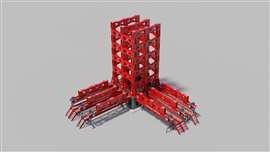 The triple beam stacking arrangement on Mammoet’s Mega Jack 10000 in operation. Image: Mammoet
The triple beam stacking arrangement on Mammoet’s Mega Jack 10000 in operation. Image: Mammoet
Being able to build large and heavy modules close to ground level means less work at height and a reduced need for special supporting steelwork.
Module construction at ground level, however, means once it is finished it has to be raised off the ground, often to a height of tens of metres. That is where Mammoet’s Mega Jack hydraulic stacking tower sytem comes in. Several sizes of Mega Jack are already available in the Mammoet fleet. Capacities per tower are 300, 500, 800 and 5,200 tonnes. Towers can be combined for extra capability, theoretically without limit.
Trying to combine too many towers might encounter problems with space under the load. Modules are getting bigger and heavier and Mammoet foresaw the need for a capacity per tower of even more than the Mega Jack 5200.
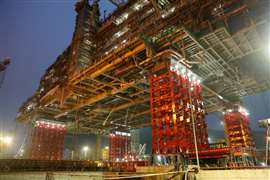 42,870 tonne world record lift used a Mega Jack system. Image: Mammoet
42,870 tonne world record lift used a Mega Jack system. Image: Mammoet
Enter the new Mega Jack 10000. As the series nomenclature suggests the number reflects the lifting capacity per tower. In this case it is actually 10,400 tonnes per tower, exactly double that of the previously range-topping Mega Jack 5200.
Crucially, while the capacity has doubled, the footprint of the tower base remains the same. It means less steel in the supports as the level rises and the starting height remains low.
Further benefits are that fewer towers are needed for heavier loads and smaller foundations mean shorter preparation time and lower cost.
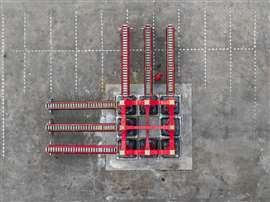 Plan view at the base of the Mega Jack 10000 tower showing the central support each side. Image: Mammoet
Plan view at the base of the Mega Jack 10000 tower showing the central support each side. Image: Mammoet
How it works
The jacking beams on the new system are 5 metres long and have three connection points. Instead of the load all being on the corners of the tower, it is distributed through eight base units, arranged with four at the corners of the tower and four more, one in the centre of each side.
For bigger lifts starter beams are used to connect the top of the jacking towers together and distribute the load between them. Two Mega Jack 5200 towers joined using a starter beam will give a capacity of 10,400 tonnes.
On the new Mega Jack 10000 one tower can lift this so the job will need fewer starter beams, less supporting steel and not so much engineering. A lower starting height can also mean smaller assist cranes.
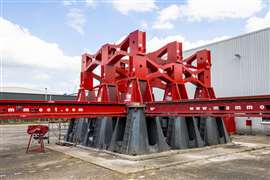 Double the support for the Mega Jack 10000 in the same footprint as the Mega Jack 5200 allows twice the load. Image: Mammoet
Double the support for the Mega Jack 10000 in the same footprint as the Mega Jack 5200 allows twice the load. Image: Mammoet
Commenting on the new Mega Jack 10000 Richard Verhoeff, Mammoet global sales director for special devices, said, “We noticed that loads were growing beyond the capacity of the Mega Jack 5200 and came up with the idea of the Mega Jack 10000. We designed an early initial concept and now we have upgraded the system to accommodate future projects that require a 10,000 tonne single tower solution.”
Also new is the control system which can measure smaller increments of lift between towers, now down to one hundredth of a millimetre. This allows closer matching meaning less stress on the supporting systems and structure when lifting.
Typical applications for Mega Jack are in offshore construction yards lifting oil and gas topsides modules, some of which now weigh more than 30,000 tonnes.
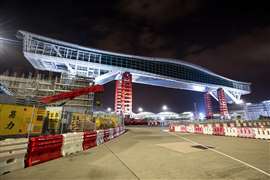 Mammoet Mega Jack in operation lifting an airport passenger bridge high enough for aircraft to pass underneath. Image: Mammoet
Mammoet Mega Jack in operation lifting an airport passenger bridge high enough for aircraft to pass underneath. Image: Mammoet




